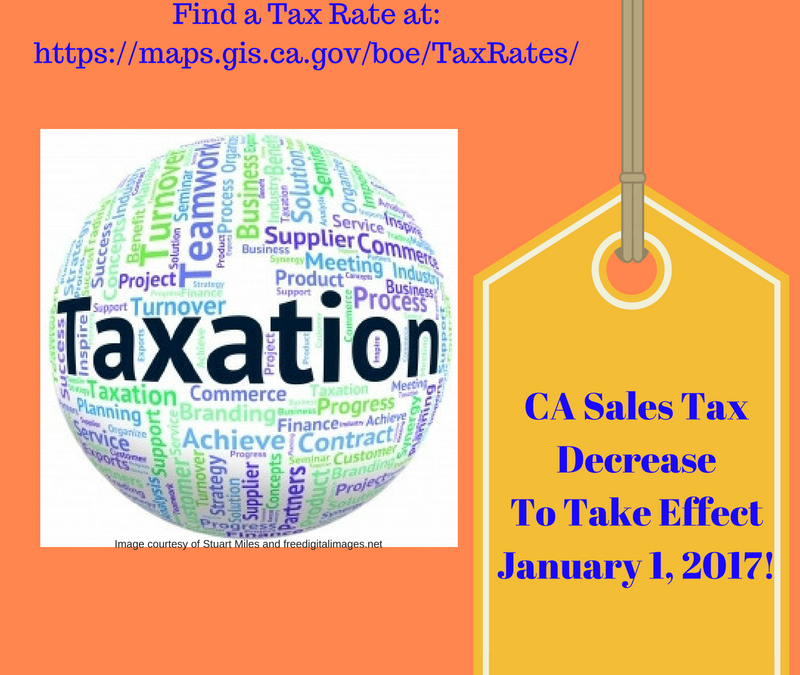An unusual occurrence is about to take place on January 1, 2017. The state-wide sales tax rate is going to DECREASE. Due to the expiration of an increase passed in 2012, the rate will drop .25% in all jurisdictions from 7.5% to 7.25%. However, the total tax rate in many cities and counties will remain higher than the statewide rate because of local voter-approved district taxes in those areas.
To find the full tax rate in your city or county, go to the Find a Sales and Use Tax Rate webpage and enter the address as prompted. (Please note that the 0.25 percent statewide tax rate decrease will not be reflected on this website until January 1, 2017). For additional information on the sales and use tax rates, you may also visit the California City & County Sales & Use Tax Rates webpage. For more information on district taxes, please see publication 44, District Taxes (Sales and Use Taxes).Below is some information you may find helpful in the event you charged too much, or are in an agreement with a fixed fee that includes sales tax in the price.
Below is some information you may find helpful in the event you charged too much, or are in an agreement with a fixed fee that includes sales tax in the price.
If a Retailer Charges an Incorrect Tax Rate
A retailer who continues to charge and collect the higher statewide sales and use tax rate after January 1, 2017, must either refund the excess tax collected to their customer or pay the excess tax to the Board of Equalization (BOE). If the excess tax collected has been paid to the BOE, the retailer may request a refund on behalf of their customer by completing form BOE-101, Claim for Refund or Credit. For information regarding filing a claim for refund on tax overpaid to the BOE, please see publication 117, Filing a Claim for Refund.
Merchandise Delivered after January 1, 2017
The applicable sales and use tax rate is the rate that is in effect at the time the sale occurs. Generally, the sale occurs when the merchandise is delivered to the customer, unless the sales contract specifically states that title to the merchandise passes to the customer prior to delivery.
Therefore, if the sales contract does not specify when title passes, most retail sales of merchandise delivered to customers on and after January 1, 2017, will be subject to the new tax rate of 7.25 percent plus any applicable district taxes. For additional information regarding when a sale occurs, please see Regulation 1628, Transportation Charges.
Returned Merchandise
The customer should be refunded the amount of tax at the rate that was charged and collected from the customer at the time of the original sale.
Fixed-Price Contracts
The statewide sales and use tax 0.25 percent rate decrease applies to all taxable sales and purchases made as part of a fixed-price contract or fixed-price lease agreement (other than certain leases of mobile transportation equipment) that were entered into prior to January 1, 2017. The decreased rate replaces the rate in effect at the time you first entered the fixed-price contract or fixed-price lease agreement.
Split Returns
For some retailers, the sales and use tax decrease becomes effective in the middle of their reporting period. As the retailer, you must separate your sales made prior to and after January 1, 2017, thereby calculating the tax at the two different rates. When filing online, the system will allow you to report the transactions using the two different rates on the split rate return and will do the rate calculations for you.
For More Information
If you have questions about the tax rate decrease, or how it may affect the overall tax rate in your area, please call our Customer Service Center at 1-800-400-7115 (TTY:711). Customer service representatives are available to assist you weekdays from 8:00 a.m. to 5:00 p.m. (Pacific time), except state holidays.
Resources
Special Notice: Sales and Use Tax Rate Decreases by 0.25 Percent Effective January 1, 2017
Please be sure to create new sales tax rates in your accounting software (don’t modify existing items or prior sales information may be affected) in order to properly record the sales tax liability you incur.
